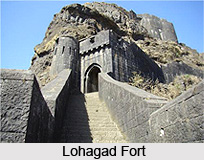 Shivaji, founder of Maratha Empire in western India in 1664, was well known for his forts. He was in possession of around 370 at the time of his death, covering a length of over a thousand kilometers, running along the Western Ghats mountain range. Many of the forts, such as the Panhala Fort and Raigad Fort existed before Shivaji but others like Sindhudurg and Pratapgad were built by him from scratch.Also, the fort of Raigad was built as the place of throne, i.e., the capital, of Maratha Empire by Hiroji Indalkar on the orders of Shivaji. This is the place where Shivaji was coronated and today also his Samadhi stands in front of the Jagadishwar temple. These forts were central to his empire and their remains are among the foremost sources of information about his rule.
Shivaji, founder of Maratha Empire in western India in 1664, was well known for his forts. He was in possession of around 370 at the time of his death, covering a length of over a thousand kilometers, running along the Western Ghats mountain range. Many of the forts, such as the Panhala Fort and Raigad Fort existed before Shivaji but others like Sindhudurg and Pratapgad were built by him from scratch.Also, the fort of Raigad was built as the place of throne, i.e., the capital, of Maratha Empire by Hiroji Indalkar on the orders of Shivaji. This is the place where Shivaji was coronated and today also his Samadhi stands in front of the Jagadishwar temple. These forts were central to his empire and their remains are among the foremost sources of information about his rule.
All of the forts have been rather remarkably constructed. Certain outstanding features can be detected in almost all of the fortifications. The most remarkable feature is the adaptable pattern of its designs. There is no monotony seen in the construction of these forts. The designs of the forts correspond to the topography and are in harmony with the contour. Unlike in the case of most other forts of the time, there is seen the absence of ornate palaces, dance floors, gardens and temple complexes in these forts of Shivaji. Most of these forts have a double line of fortifications such as Pratapgad fort, Rajgad etc and there can be seen a remarkable foresight in the selection of the sites of the fort. There is not much difference in the area of the higher or lower ranks and there existed a system of inspection of forts by higher ups including the king. Other features of these forts include marvellous acoustics in the capital, community participation in the defense of forts, three tier administrations of forts and the sanskritisation of fort names.
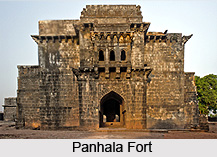 These forts have been central to his empire and they remain one of the foremost sources that provide information about his rule. The technical know-how and knowledge of Shivaji is amply evident in the construction of the Gingee fort in Chennai.
These forts have been central to his empire and they remain one of the foremost sources that provide information about his rule. The technical know-how and knowledge of Shivaji is amply evident in the construction of the Gingee fort in Chennai.
Some of the hill forts which were spread over long distances were supported by sea forts. For instance, the hill fort of Salher in Nashik district was at a distance of 1,200km from the hill fort of Gingee, near Chennai. Over such long distance, hill forts were supported by sea-forts. The sea fort of Kolaba, near Mumbai was at a distance of 500km from the sea-fort of Sindhudurg. All of these forts were put under the control of a havaldar with a strong garrison, and rather strict discipline was maintained. These forts were of much use during the Mughal-Maratha wars.
Chatrapati Shivaji Maharaj Fort List: Along with Rana Kumbha of Mewar and Raja Bhoj of Shilahar, he stands as a grand figure in the art of fortification in Indian sub-continent. There are a number of legends about these forts. Even today thousands of youths visit these forts in his memory.
Lohagad
Lohagad is one of the many hill forts of Maharashtra in India.
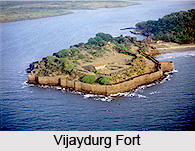 It is situated close to the hill station Lonavala and 52 km northwest of Pune. The fort is connected to the neighboring Visapur fort by a small range. Shivaji recaptured the fort in 1670 and used it for keeping his treasury. This fort was used to keep the loot from Surat.
It is situated close to the hill station Lonavala and 52 km northwest of Pune. The fort is connected to the neighboring Visapur fort by a small range. Shivaji recaptured the fort in 1670 and used it for keeping his treasury. This fort was used to keep the loot from Surat.
Panhala Fort
Panhala fort also known as Panhalgad, Pahalla and Panalla (literally "the home of serpents"), is located in Panhala, 20 kilometres northwest of Kolhapur in Maharashtra, India. Here, the queen regent of Kolhapur, Tarabai, spent her formative years. Several parts of the fort and the structures within are still intact. Panhala fort was built between 1178 and 1209, one of 15 forts built by the Shilahara ruler Bhoja II.
Vijaydurg Fort
Vijaydurg, the oldest fort on the Sindhudurg coast, was constructed during the regime of Raja Bhoja II of the Shilahar dynasty. The fort was earlier known as "Gheria", as it is situated close to the village of "Girye". Shivaji captured this fort from Adil Shah of Bijapur in 1653 and renamed it as "Vijay Durg".
Earlier, the fort encompassed an area of 5 acres and was surrounded by sea on all four sides. Over the years the eastern trench was reclaimed and a road constructed thereon.
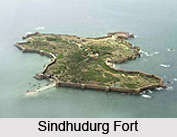 Presently the area of fort is about 17 acres and is surrounded by the Arabian Sea on three sides. Shivaji extended the area of the fort by constructing three walls on the eastern side, each 36m high. He also constructed 20 bastions.
Presently the area of fort is about 17 acres and is surrounded by the Arabian Sea on three sides. Shivaji extended the area of the fort by constructing three walls on the eastern side, each 36m high. He also constructed 20 bastions.
According to legend, this is one of only two Maratha forts where Shivaji personally hoisted the saffron flag. The other fort is "Torna".
Vijaydurg Fort was called the "Eastern Gibraltar", as it was virtually secure. Its locational advantages include the 40 km long Waghotan/Kharepatan creek. Large vessels cannot enter the shallow water of this creek. Also, Maratha warships could be anchored in this creek and yet remain invisible from the sea. It is a protected monument.
Ghodbunder Fort
Ghodbunder Fort is a located in Ghodbunder Village, Thane, Maharashtra, India, on the hill just south of the Ulhas River. The place was called as Ghodbunder because in was where the Portuguese used to trade for ghode (horses) with the Arabs. Hence the name Ghodbunder: ghode (horses) & bunder (port).
Sajjangad
Sajjangad meaning "Fort of Good People" is located near the city of Satara, India. It is the final resting place of Sant Ramdas, a saint, Guru of Chatrapati Shivaji and social reformer in 17th century India. Previously known as Parali, it was renamed to Sajjangad after Shivaji Maharaj requested Shri Ramdas Swami to set up his permanent monastery.
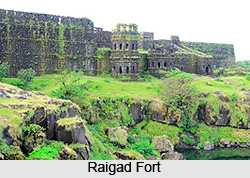
Bhuikot
Bhuikot means a fort that is built on flat land and not on any mountain. "Bhui" means Land in Marathi and "Kot" means Killa or Fort. Most forts during the Shivaji`s era were built atop mountains. However, certain forts were also built on flat land.
Torna Fort
Torna Fort is a large fort located in Pune district in the state of Maharashtra, India. It is historically significant because it is the first fort captured by Shivaji Maharaj in 1643, at the age of 16 forming the nucleus of the Maratha Empire. The hill has an elevation of 1,403m above sea level, making it the highest hill-fort in the district. A Menghai Devi temple, also referred to as the Tornaji temple, is situated near the entrance of the fort.
Sindhudurg Fort
Sindhudurg is a fort which occupies an islet in the Arabian Sea, just off the coast of Maharashtra in western India. The fortress lies on the shore of Malvan town of Sindhudurg District in the Konkan region of Maharashtra, south of Mumbai. It is a protected monument. This fort was constructed by Shri Chhatrapati Shivaji Maharaj, today also we can see his foot & palm print in fort. The construction was done under the supervision of Hiroji Indulkar, in the year 1656.
Raigad Fort
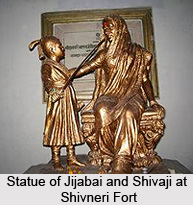 Raigad is a hill fort situated in the Mahad, Raigad district of Maharashtra, India. Shivaji made the fort his capital in 1674 when he was crowned King of a Maratha Kingdom.
Raigad is a hill fort situated in the Mahad, Raigad district of Maharashtra, India. Shivaji made the fort his capital in 1674 when he was crowned King of a Maratha Kingdom.
The fort, which rises 820m above sea level, is located in the Sahyadri mountain range. There are approximately 1737 steps leading to the fort, though today an aerial tram exists to reach the top of the fort. In 1818 the fort was bombarded and destroyed by, using cannons.
Shivneri
Shivneri Fort is a 17th-century military fortification located near Junnar. It is the birthplace of Chhatrapati Shivaji, the founder of Maratha Empire.
Chhatrapati Shivaji was born at the fort on 19 February 1630, and spent his childhood there. Inside the fort is a small temple dedicated to the goddess Shivai Devi, after whom Shivaji was named. There are statues of Jijabai and young Shivaji. It has been declared as a protected monument. There are many gates structures protecting this fort. Mana Darwaza is one of the many gates on Shivneri fort.



















